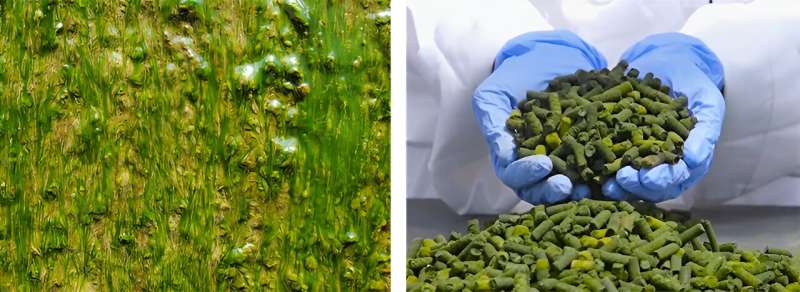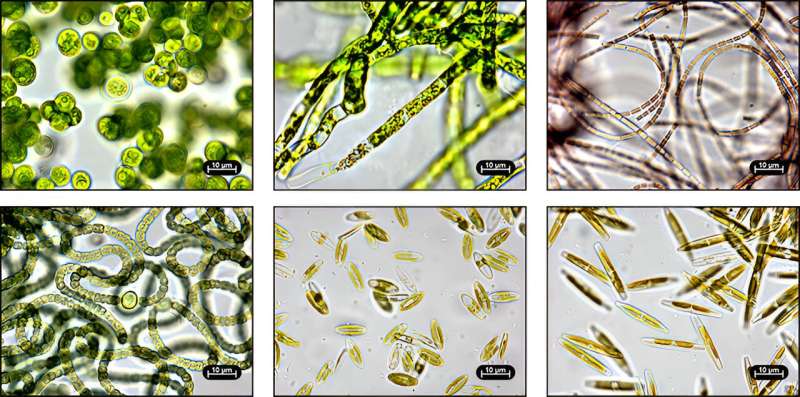This article has been reviewed according to Science X's editorial process and policies. Editors have highlighted the following attributes while ensuring the content's credibility:
fact-checked
peer-reviewed publication
trusted source
proofread
Newly identified algal strains rich in phosphorus could improve wastewater treatment

Phosphorus in wastewater is a major contributor to harmful algal blooms in water bodies around the globe, with the potential to harm wildlife, livestock, and even humans. To prevent this, wastewater treatment plants often rely on chemical- and energy-intensive techniques to remove phosphorus before it can impact downstream water bodies.
National Renewable Energy Laboratory (NREL) researchers sought to develop new technology for phosphorus removal from wastewater by maximizing the ability of algae to harness solar energy to efficiently accumulate and remove phosphorus from water, storing it inside the cell as polyphosphate.
The Revolving Algal Biofilm (RAB) system by Gross-Wen Technologies is an emerging technology that does just that. In the RAB system, phosphorus-laden algae are cultivated in wastewater attached to a revolving belt. The grown algal biomass can then be harvested from the belt and dried for use as agricultural fertilizer or as feedstock for the manufacture of biofuels and bioproducts. This process can help close the phosphorus-cycle loop by recycling and reusing the phosphorus in wastewater, decreasing demand on limited minable phosphorus resources.
Now researchers from NREL, Gross-Wen Technologies, and the Metropolitan Water Reclamation District of Greater Chicago have partnered under a Technology Commercialization Fund (TCF) grant through the U.S. Department of Energy (DOE) to further develop the RAB system. TCF grants aim to bring new energy technologies to market by applying DOE funds and national laboratory expertise and infrastructure.
The team of researchers examined the unique properties of phosphorus uptake in the algal strains living in RAB systems. In a study published in the journal Frontiers in Microbiology, the team detailed how specific algal species outperform the broader population of algae in the system. These findings may offer insight to improve RAB performance while enhancing revenue streams for crop fertilizers or bioenergy feedstocks.
"We were curious to know which of the algae species living in these systems were doing the heaviest lifting in removing the phosphorus from wastewater," Eric Schaedig, NREL researcher and lead author of the study said. "From a biological perspective, if we can isolate and enrich RAB systems with these hardworking algal species, it would boost the efficiency of the overall system and help us close the loop on the phosphorus cycle."
Why optimizing algal biofilm systems can boost efficiency
An interesting behavior of algae is their ability to take up phosphorus at levels that surpass their immediate nutritional needs. This process is called "luxury uptake" and is one of the benefits of using algae to treat wastewater and reclaim nutrients, especially for RAB systems.
In a RAB system, a community of algae adhere as a biofilm to a vertical, revolving belt partially submerged in the wastewater. As they grow, the algae absorb phosphorus and other pollutants from the wastewater while underwater and absorb carbon dioxide and sunlight while above the water. This unique environment supports many algae, and the NREL team sought to isolate and characterize these organisms.
Schaedig said that the process of isolating and characterizing algal strains native to the RAB systems is one way to optimize these systems. Once phosphorus-hyperaccumulating algal strains are isolated and identified in the lab, they can be reintroduced to other RAB systems and prosper, improving phosphorus uptake by the RAB systems.

Among 101 algae strains identified, seven possessed high levels of polyphosphate
The researchers isolated nearly 770 algal strains from biofilm samples collected across eight active RAB systems throughout Iowa and Illinois. "Many of these were duplicates of the same algal species, and we pared that number down to 101 unique strains using microscopy," Schaedig said. Those 101 unique strains were identified using DNA sequencing, and the polyphosphate content of each was determined using advanced screening techniques.
The results were promising. Seven isolated algal strains possessed at least 50% more polyphosphate by cell dry weight (CDW) compared to a baseline RAB system algal community, which came in at 5.1% polyphosphate by CDW. The top phosphorus-hyperaccumulating strain, Craticula molestiformis TCF-8d, accumulated 14.0% polyphosphate by CDW.
Researchers also discovered that RAB-system algal communities varied across sample locations and time points, suggesting that RAB communities may change due to seasonal shifts in light and temperature or wastewater composition.
The research team performed follow-up experiments to confirm whether the top hyperaccumulating algal strains would survive and grow in real-world RAB systems. One of the strains, Chlamydomonas pulvinata, showed strong performance, thriving in the system and boosting the phosphorus removal rate of the modified system to 70%, double the removal rate of an unmodified RAB biofilm community.
Promise of resource recovery beyond phosphorus
Phosphorus is a vital nutrient for all life on Earth, and our daily lives are full of it. The food we eat and the products we slather and scrub onto our bodies are rich in phosphorus, which is eventually flushed out of our homes in the wastewater we produce. This phosphorus-rich wastewater is destined for streams, creeks, and lakes, where it can spur harmful algal blooms that starve these aquatic ecosystems of life-supporting oxygen.
This research has shown that phosphorus-hyperaccumulating algae have the potential to help us capture and reuse the phosphorus that we emit into the environment before it can exact its toll on aquatic ecosystems. This can not only help prevent harmful algal blooms in aquatic ecosystems but can also create a closed-looped cycle for the phosphorus we rely on. In addition to phosphorus recovery, the results from this research may have additional benefits for the recovery and reuse of other valuable resources lost in wastewater.
"The beauty of this research into phosphorus-hyperaccumulating algae is its implication beyond just phosphorus recovery," said Jianping Yu, principal investigator at NREL and senior author of the study. "Polyphosphate is known to bind to and accumulate metals in algae. So, the strains isolated in this study may be promising for other algal waste-remediation applications, like removing or recovering harmful or valuable metals from industrial processes and wastewater."
More information: Eric Schaedig et al, Isolation of phosphorus-hyperaccumulating microalgae from revolving algal biofilm (RAB) wastewater treatment systems, Frontiers in Microbiology (2023). DOI: 10.3389/fmicb.2023.1219318
Journal information: Frontiers in Microbiology
Provided by National Renewable Energy Laboratory





















